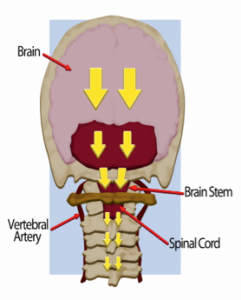 A new study from neuroscientists at the Wayne State University School of Medicine provides the first novel insights into the neural origins of hot flashes in menopausal women in years1.
A new study from neuroscientists at the Wayne State University School of Medicine provides the first novel insights into the neural origins of hot flashes in menopausal women in years1.
Previously I had written about hormonal headaches and a concept called “allostasis”. Allostasis is the process of achieving nervous system stability through physiological or behavioural change. When the nervous system fails to adapt, you become unwell or express symptoms.
The spine is the brain’s circuit board for the body. When it’s overloaded, it will short circuit (sometimes through a hot flush) and the spine will misalign to adapt to the overload. See non-traumatic causes of upper neck misalignment for more.
This study points to plausible origins of hot flashes in specific brain regions, namely the brainstem. The researchers believe it is the first such demonstration in academic literature.
The researchers focused on regions like the brainstem because its sub-regions, such as the medullary and dorsal raphe, are implicated in thermal regulation, while forebrain regions, such as the insula, have been implicated in the personal perception of how someone feels. They showed that activity in some brain areas, such as the brainstem, begins to rise before the actual onset of the hot flash2.
 Alterations to brainstem activity make sense now as to why so many women going through perimenopause, or menopause itself, experience such a wide variety of symptoms. The brainstem is the body’s main fuse box. It has many sub-fuses which control sleep, blood pressure, vertigo, gut, breathing, as well as pain modulation (why some women are more sensitive to pain).
Alterations to brainstem activity make sense now as to why so many women going through perimenopause, or menopause itself, experience such a wide variety of symptoms. The brainstem is the body’s main fuse box. It has many sub-fuses which control sleep, blood pressure, vertigo, gut, breathing, as well as pain modulation (why some women are more sensitive to pain).
It’s because of these changes to brainstem and upper cervical spine that menopausal women represent the most challenging subset of clients because they can experience such a vast array of symptoms; find it difficult to hold their adjustments for any length of time; and the problems can come and go over a number of years through mid-40s to early 50s.
“The idea of understanding brain responses during thermoregulatory events has spawned many studies where thermal stimuli were applied to the skin. But hot flashes are unique because they are internally generated, so studying them presents unique challenges,” said Freedman, the study’s principal investigator. “Our participants had to lie in the MRI scanner while being heated between two body-size heating pads for up to two hours while we waited for the onset of a hot flash. They were heroic in this regard and the study could not have been conducted without their incredible level of cooperation.”
The researchers collected skin conductance levels to identify the onset of flashes while the women were being scanned. Skin conductance is an electrical measure of sweating. The women were connected to a simple circuit passing a very small current across their chests. Changes in levels allowed researchers to identify a hot flash onset and analyse the concurrently acquired fMRI data to investigate the neural precedents and correlates of the event.
This study appeared in the June issue of Cerebral Cortex2, an Oxford University Press journal.
References:
